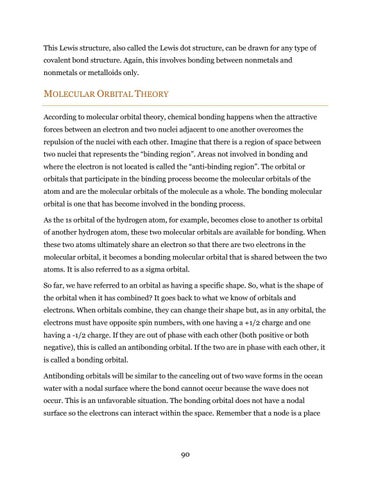This Lewis structure, also called the Lewis dot structure, can be drawn for any type of covalent bond structure. Again, this involves bonding between nonmetals and nonmetals or metalloids only.
MOLECULAR ORBITAL THEORY According to molecular orbital theory, chemical bonding happens when the attractive forces between an electron and two nuclei adjacent to one another overcomes the repulsion of the nuclei with each other. Imagine that there is a region of space between two nuclei that represents the “binding region”. Areas not involved in bonding and where the electron is not located is called the “anti-binding region”. The orbital or orbitals that participate in the binding process become the molecular orbitals of the atom and are the molecular orbitals of the molecule as a whole. The bonding molecular orbital is one that has become involved in the bonding process. As the 1s orbital of the hydrogen atom, for example, becomes close to another 1s orbital of another hydrogen atom, these two molecular orbitals are available for bonding. When these two atoms ultimately share an electron so that there are two electrons in the molecular orbital, it becomes a bonding molecular orbital that is shared between the two atoms. It is also referred to as a sigma orbital. So far, we have referred to an orbital as having a specific shape. So, what is the shape of the orbital when it has combined? It goes back to what we know of orbitals and electrons. When orbitals combine, they can change their shape but, as in any orbital, the electrons must have opposite spin numbers, with one having a +1/2 charge and one having a -1/2 charge. If they are out of phase with each other (both positive or both negative), this is called an antibonding orbital. If the two are in phase with each other, it is called a bonding orbital. Antibonding orbitals will be similar to the canceling out of two wave forms in the ocean water with a nodal surface where the bond cannot occur because the wave does not occur. This is an unfavorable situation. The bonding orbital does not have a nodal surface so the electrons can interact within the space. Remember that a node is a place
90




























